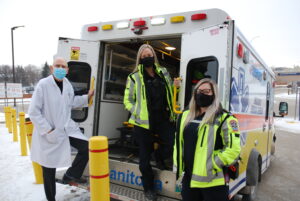February 12, 2021
It was December 23rd, and Rosauro Rosales, 57, was relaxing with his common-law partner, Genesis Mallen, and her sister, Yzel Mallen, in their St. James home.
Rosales had called his sisters in Toronto for a chat earlier in the evening. At around 9 p.m., they were watching a show on Netflix when “suddenly, out of nowhere, Rosauro started feeling pain in his chest,” said Genesis Mallen, noting Rosales had no medical history of heart problems.
“I asked him if it was a pinching pain, or heavy like something was pressing on his chest,” she recalled. “He felt the heaviness, and his pain was severe and increasing. He was nervous, worried it was a heart attack; but we were not sure.”
The couple then made a decision that might well have saved his life. “He was preparing to drive himself to the nearest hospital. I said, ‘If it’s a heart attack, you could endanger others if you got into an accident while driving.’ My sister and I told him to call an ambulance instead, just to be safe, and he agreed,” said Mallen.
“If it’s a heart attack, you could endanger others if you got into an accident while driving.”

They made the right choice by dialing 911, said Dr. John Ducas, Medical Director of the Manitoba Acute Coronary Syndrome (ACS) Network.
“St. Boniface is Manitoba’s Cardiac Centre of Excellence, and we are here and trying to help you. We want you to know, if you are witnessing or experiencing signs of a heart attack how important it is to dial 911 or your local emergency number,” said Ducas.
There are two types of heart attacks, the more serious of which is called a STEMI, where a main heart artery is suddenly blocked by a blood clot. If left untreated, one in four STEMI patients will die in the first few hours or days.
The way to treat a STEMI is to remove the blood clot. “If you unblock the artery, the chance of you dying from a STEMI drops to about one in ten or so,” said Ducas.
There are two ways that can be done, according to Ducas. One of them is an angioplasty, an operation in which an artery can be unblocked and widened with a small balloon. “This works very quickly and effectively,” he said. St. Boniface Hospital is the only facility in the province equipped to provide heart angiogram X-ray treatments like angioplasty.
“If you very quickly unblock the artery with angioplasty treatment, then the chance of you dying drops to less than one in 20. So, your best chance of living, and the best chance of reducing any damage that may give you problems like heart failure or arrhythmia (heartbeat out of rhythm) in the future, is getting this angioplasty to rapidly unblock the heart artery.”
The second way to treat a STEMI is with a blood clot-melting intravenous (IV) drug. “This is not as fast, not as effective, and surprisingly, is quite expensive,” said Ducas.
If a patient is far outside of Winnipeg and they cannot reach St. Boniface Hospital by ambulance in about 1.5 hours or less, then they are better off at that point getting the clot-melting IV drug at a local hospital. After that, all such heart attack patients are sent to St. Boniface Hospital by ground or air ambulance/helicopter, to make sure the artery was unblocked and for further treatment.
“But your best chance at surviving a STEMI, and your best chance of reducing any chance of you having heart problems in the future, no matter where in Manitoba you live, is by calling 911 or your local emergency number and being treated quickly.”
Driving can be deadly

Back on December 23rd, Rosauro Rosales and Genesis Mallen dialed 911. “It was crucial that we called an ambulance – so that if it was a heart attack, they could do whatever was necessary to avoid any further damage to his heart,” she said. “They arrived in less than five minutes.”
Dialing 911 can shorten a patient’s time to get treated by as much as 40 to 50 minutes. “Within the city of Winnipeg, there were about 450 STEMIs last year, with about 100 more in the surrounding communities,” said Ducas.
“Tragically, only about half of those patients dialed 911. Many of the rest were gripped by fear, panic, or denial. They came to the Hospital by taxi or in their own vehicles – some even drove themselves. It’s the wrong decision,” he said.
“Now I have personally treated patients who have crashed their cars because they get that arrhythmia on the way to the Hospital,” said Ducas.
“The moment you dial 911 – if you’re in the city it’s five to seven minutes, if you’re outside the city, 10 to 15 minutes – and as soon as they show up with the defibrillator the ambulance crew can put your heart in arrythmia back to normal, then your life may be saved.”
“People misunderstand this: you hear somebody ‘died suddenly of a massive heart attack.’ You don’t need have to have a massive heart attack to get the arrythmia and die. You can have a relatively small heart attack that causes the arrhythmia. You can die of the arrythmia, and not of the heart damage,” he said.
Turns out, Rosales did have a heart attack last December. He got the angioplasty treatment at St. Boniface Hospital and survived.
“That night I got a call from his doctor, who said it was good thing that we did not let him drive. He could have caused an accident, or he could have gone to a hospital other than St. Boniface, that is not equipped as well for heart attacks. It was a good thing we called the ambulance, because they knew where to bring him for the treatment he needed,” said Mallen.
“It was scary, but we got the best-possible Christmas gift. We got his life.”


